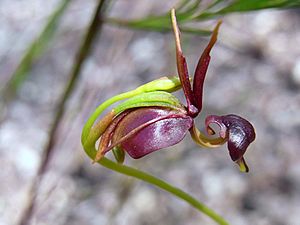George Caley facts for kids
Quick facts for kids
George Caley
|
|
|---|---|
| Born | 10 June 1770 Craven, Yorkshire, England
|
| Died | 23 May 1829 (aged 58) London, England
|
| Occupation | Botanist and explorer |
| Known for | Caleana, Grevillea caleyi, Viola caleyana, Banksia caleyi, and Eucalyptus caleyi Discovery of Mount Banks, Australia |
| Scientific career | |
| Institutions | Kew Gardens |
| Patrons | Sir Joseph Banks |
| Author abbrev. (botany) | Caley |
George Caley (born June 10, 1770 – died May 23, 1829) was an English botanist and explorer. He spent most of his career studying plants in Australia.
Contents
Early Life and Plant Studies
George Caley was born in Craven, Yorkshire, England. His father was a horse-dealer. George went to the Free Grammar School in Manchester for about four years. After school, he worked in his father's stables.
He became interested in plants after reading a book about horse medicine. He taught himself about botany by studying books like 'Botanical arrangement' by William Withering. To spend more time on his plant studies, he even changed his job to become a weaver. He joined a group called the Manchester School of Botanists.
In 1795, he wrote to Sir Joseph Banks, a famous botanist. Banks warned him that botanists didn't earn much money. However, Banks offered him a job as a gardener's helper. This job gave Caley chances to learn even more about plants. He worked in famous places like Kew Gardens in England.
Exploring Australia's Plants
In 1798, Sir Joseph Banks hired Caley to collect plants in New South Wales, Australia. Caley traveled to Sydney on a ship called the Speedy, arriving on April 15, 1800. He was paid weekly and given a small house in Parramatta.

Governor King, the leader of the colony, planned to create a botanical garden near Caley's home. Caley had a special helper named Daniel Moowattin. Daniel was an Aboriginal man from the Darug people. He helped Caley as an interpreter and guide. Daniel also helped collect plants and animals during their trips around Sydney.
Caley sent many plant and animal samples back to Banks in England. His letters also shared important information about the colony and scientific discoveries. George Caley was the first person to seriously study the Eucalyptus trees in Australia.
In 1801, Caley went with Lieutenant James Grant to a place called Western Port. In 1804, he wrote a long report for Governor King. This report was about a journey to find the edges of the "Cowpastures" forest. He reported that the wild cattle there had grown a lot in number.
Crossing the Blue Mountains
In November 1804, Caley tried to cross the Blue Mountains. He had three helpers who were convicts. He reached and climbed a mountain he named Mount Banks. From there, he saw amazing views of the huge cliffs of the Grose Valley. He decided to turn back, not knowing he was very close to the other side of the mountains.
In October 1805, he visited Norfolk Island. He then traveled to Hobart in Tasmania in November of that year.
By 1808, Caley was feeling homesick for England. Sir Joseph Banks offered him a yearly payment if he wanted to stay in Australia. But Caley decided to return home.
Later Life and Legacy
George Caley returned to England in 1810. In 1816, he became the curator (manager) of the botanic gardens in St Vincent, in the West Indies. He left this job in 1822 and was back in England by May 1823. He passed away on May 23, 1829. He had married in 1816, but his wife died before him, and they did not have children.
Governor King described Caley as a bit unique and sometimes grumpy. Both Banks and King found him difficult at times. However, they agreed he was a very good worker. He was a skilled and careful botanist, and he was always honest.
Caley did not publish any books himself. But the many plants he collected helped people learn a lot about Australian plants in the early 1800s. Today, botanists use the short name Caley when they write about plants he discovered.
George Caley is remembered in several place names. These include a reserve and a pavilion at Ku-ring-gai Wildflower Garden in St Ives. Many plants are also named after him, such as the orchid genus Caleana (like the Flying Duck Orchid). Other plants include Grevillea caleyi, Viola caleyana, Banksia caleyi, and Eucalyptus caleyi. A group called the George Caley Society was started in St Ives, New South Wales, in 2019.
See also
- List of Blue Mountains articles
- List of gardener-botanist explorers of the Enlightenment

